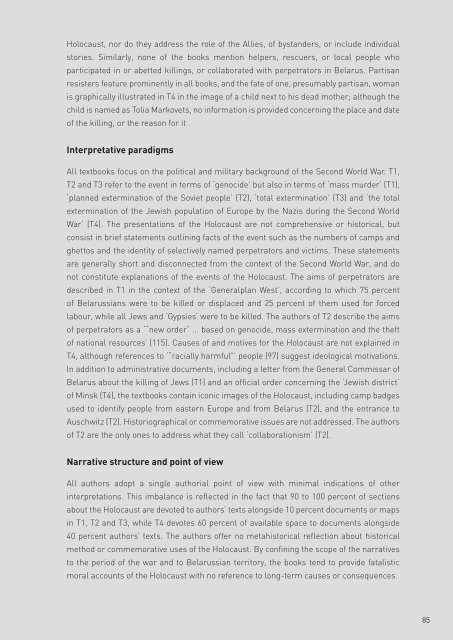228776e
228776e
228776e
You also want an ePaper? Increase the reach of your titles
YUMPU automatically turns print PDFs into web optimized ePapers that Google loves.
Holocaust, nor do they address the role of the Allies, of bystanders, or include individual<br />
stories. Similarly, none of the books mention helpers, rescuers, or local people who<br />
participated in or abetted killings, or collaborated with perpetrators in Belarus. Partisan<br />
resisters feature prominently in all books, and the fate of one, presumably partisan, woman<br />
is graphically illustrated in T4 in the image of a child next to his dead mother; although the<br />
child is named as Tolia Markovets, no information is provided concerning the place and date<br />
of the killing, or the reason for it .<br />
Interpretative paradigms<br />
All textbooks focus on the political and military background of the Second World War. T1,<br />
T2 and T3 refer to the event in terms of ‘genocide’ but also in terms of ‘mass murder’ (T1),<br />
‘planned extermination of the Soviet people’ (T2), ‘total extermination’ (T3) and ‘the total<br />
extermination of the Jewish population of Europe by the Nazis during the Second World<br />
War’ (T4). The presentations of the Holocaust are not comprehensive or historical, but<br />
consist in brief statements outlining facts of the event such as the numbers of camps and<br />
ghettos and the identity of selectively named perpetrators and victims. These statements<br />
are generally short and disconnected from the context of the Second World War, and do<br />
not constitute explanations of the events of the Holocaust. The aims of perpetrators are<br />
described in T1 in the context of the ‘Generalplan West’, according to which 75 percent<br />
of Belarussians were to be killed or displaced and 25 percent of them used for forced<br />
labour, while all Jews and ‘Gypsies’ were to be killed. The authors of T2 describe the aims<br />
of perpetrators as a ‘“new order” … based on genocide, mass extermination and the theft<br />
of national resources’ (115). Causes of and motives for the Holocaust are not explained in<br />
T4, although references to ‘“racially harmful”’ people (97) suggest ideological motivations.<br />
In addition to administrative documents, including a letter from the General Commissar of<br />
Belarus about the killing of Jews (T1) and an official order concerning the ‘Jewish district’<br />
of Minsk (T4), the textbooks contain iconic images of the Holocaust, including camp badges<br />
used to identify people from eastern Europe and from Belarus (T2), and the entrance to<br />
Auschwitz (T2). Historiographical or commemorative issues are not addressed. The authors<br />
of T2 are the only ones to address what they call ‘collaborationism’ (T2).<br />
Narrative structure and point of view<br />
All authors adopt a single authorial point of view with minimal indications of other<br />
interpretations. This imbalance is reflected in the fact that 90 to 100 percent of sections<br />
about the Holocaust are devoted to authors’ texts alongside 10 percent documents or maps<br />
in T1, T2 and T3, while T4 devotes 60 percent of available space to documents alongside<br />
40 percent authors’ texts. The authors offer no metahistorical reflection about historical<br />
method or commemorative uses of the Holocaust. By confining the scope of the narratives<br />
to the period of the war and to Belarussian territory, the books tend to provide fatalistic<br />
moral accounts of the Holocaust with no reference to long-term causes or consequences.<br />
85




